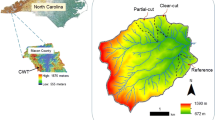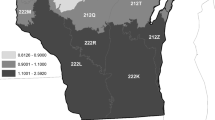Abstract
The Lower Mississippi Alluvial Valley (LMAV) originally supported at least 10 million ha of bottomland hardwood (BLH) forests. Many of these forests were wetlands and provided a diversity of values that were not recognized fully until at least one-half of the original forested area had been converted primarily to row-crop agriculture. Efforts to restore these forests have expanded in proportion to growing recognition of their unique values. This paper provides a summary resulting from a survey of BLH afforestation by all agencies and private entities in Arkansas, Louisiana, and Mississippi, the three states in the LMAV with the most restoration activity and, more specifically, by the U.S. Fish and Wildlife Service, the U.S.D.A. Natural Resources Conservation Service, and state wildlife management agencies, the three entities responsible for approximately 95% of the afforestation in this region. There is a promising trend in the annual increase of BLH afforestation across the LMAV. Approximately 71,000 ha have been planted with BLH species through 1998; however, this represents <1% of the BLH forests that have been lost, and afforestation does not ensure restoration of all ecological functions. No clear choice between planting stocks (bareroot seedlings or direct seeding) or among planting seasons (Fall, Winter, Spring, or Summer) is prevalent among those involved in BLH afforestation. Much of the early afforestation used oaks (Quercus spp.) to accelerate replacement of mast-bearing species. Recently, mixtures of species have been incorporated into afforestation regimes. More light-seeded species and a more diverse component of oak species have been planted to mimic a more natural regeneration process. Successful widescale afforestation is a critical link in restoration of functional BLH ecosystems in this region.
Similar content being viewed by others
Literature Cited
Allen, J. A. 1997. Reforestation of bottomland hardwoods and the issue of woody species diversity. Restoration Ecology 5: 125–34.
Allen, J. A. and H. E. Kennedy, Jr. 1989. Bottomland hardwood reforestation in the Lower Mississippi Valley. Bulletin, U. S. Department of the Interior, Fish and Wildlife Service, National Wetlands Research Center, Slidell, LA, USA and U.S. Department of Agriculture, Forest Service, Southern Forest Experiment Station. Stoneville, MS, USA.
Brabander, J. J., R. E. Masters, and R. M. Short. 1985. Bottomland hardwoods of eastern Oklahoma: a special study of their status, trends, and values. U.S. Fish and Wildlife Service and Oklahoma Department of Wildlife Conservation, Tulsa, OK, USA.
Brinson, M. M. 1990. Riverine forests, p. 87–141. In A. E. Lugo, M. M. Brinson, and S. Brown (eds.) Ecosystems of the World 15: Forested Wetlands. Elsevier, Amsterdam, The Netherlands.
Burns, R. M. and B. H. Honkala (tech. coords.). 1990. Silvics of North America: 1. Conifers; 2. Hardwoods. U.S. Department of Agriculture, Forest Service, Washington, DC, USA. Agriculture Handbook 654, vol. 2.
Frye, R. G. 1987. Bottomland hardwoods-Current supply, status, habitat, quality, and future impacts from reservoirs. p. 24–27. In C. A. McMahan and R. G. Frye (eds.) Bottomland Hardwoods in Texas. Texas Parks and Wildlife, Austin, TX. USA. Publication PWD-RP-7100-133-3/87.
Harris, L. D. and J. G. Gooselink. 1990. Cumulative impacts of bottomland hardwood forest conservation in hydrology, water quality, and terrestrial, wildlife. p. 259–322. In J. G. Gosselink, L. C. Lee, and T. A. Muir (eds.) Ecological Processes and Cumulative Impacts: Illustrated by Bottomland Hardwood Ecosystems. Lewis Publishers, Boca Raton, FL, USA.
Haynes, R. J., R. J. Bridges, S. W. Gard, T. W. Wilkins, and H. R. Cook, Jr. 1995. Bottomland hardwood reestablishment efforts of the U.S. Fish and Wildlife Service: Southeast Region. p. 322–334. In J. C. Fischenich, C. M. Lloyd, and M. R. Palmero (eds.), Proceedings of the National Wetlands Engineering Workshop. U.S. Army Corps of Engineers, Waterways Experiment Station, Vicksburg, MS, USA. Technical Report-WRP-RE-8.
Hefner, J. M. and J. D. Brown. 1985. Wetland trends in the southeastern United States. Wetlands 4:1–11.
King, S. L. and B. D. Keeland. 1999. Evaluation of reforestation of the Lower Mississippi River Alluvial Valley. Restoration Ecology 7:348–359.
Leitch, J. A., W. B. Clifford, J. L. Richardson, and J. H. Sather. 1994. Wetland Policy Issues. Council for Agricultural Science and Technology (CAST). Ames, IA, USA.
MacDonald, P. O., W. E. Frayer, and J. K. Clauser. 1979. Documentation, chronology, and future projections of bottomland hardwood habitat loss in the lower Mississippi Alluvial Plain, Volume 1, Basic Report. HRB-Singer, Incorporated, State College, PA, USA.
Mitsch, W. J. and J. G. Gosselink. 2000. Wetlands, third edition. John Wiley and Sons, Inc. New York, NY, USA.
National Research Council. 1992. Restoration of Aquatic Ecosystems: Science, Technology, and Public Policy. National Academy Press, Washington, DC, USA
Newling, C. J. 1990. Restoration of bottomland hardwood forests in the Lower Mississippi Valley. Restoration and Management Notes 8:23–28.
Rudis, V. A. 1995. Regional forest fragmentation effects on bottomland hardwood community types and resource values. Landscape Ecology 10:291–307.
Stanturf, J. A., E. S. Gardiner, P. Hamel, M. S. Devall, T. D. Leininger, and M. E. Warren, Jr. 2000. Restoring bottomland hardwood ecosystems in the Lower Mississippi Alluvial Valley. Journal of Forestry 98:10–16.
Stanturf, J. A., S. H. Schoenholtz, C. J. Schweitzer, and J. P. Shepard. 2001. Achieving restoration success: Myths in bottomland hardwood forests. Restoration Ecology 9:189–210.
United States Congress. 1987. The Agricultural Credit Act of 1987 Public Law 100–233. U.S. Congress, Washington, DC, USA
Walbridge, M. R. 1993. Functions and values of forested wetlands in the southern United States. Journal of Forestry 91:15–19.
Want, W. L. 1989. Law of Wetlands Regulation. Clark Boardman Comp. Ltd. New York, NY, USA.
Author information
Authors and Affiliations
Corresponding author
Rights and permissions
About this article
Cite this article
Schoenholtz, S.H., James, J.P., Kaminski, R.M. et al. Afforestation of bottomland hardwoods in the Lower Mississippi Alluvial Valley: Status and trends. Wetlands 21, 602–613 (2001). https://doi.org/10.1672/0277-5212(2001)021[0602:AOBHIT]2.0.CO;2
Received:
Revised:
Accepted:
Issue Date:
DOI: https://doi.org/10.1672/0277-5212(2001)021[0602:AOBHIT]2.0.CO;2




